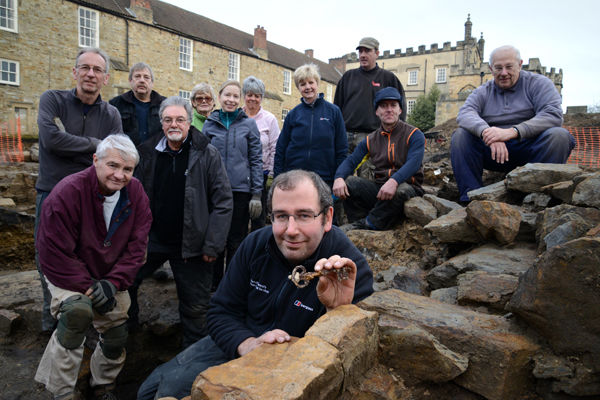A major archaeological excavation of 900-year old Auckland Castle has provided rare insight into the medieval castle’s architectural structure and history
Experts have announced the discovery of a number of rare and unexpected artefacts, and revealed the previously unknown scale of the building, which appears to have a much larger footprint than the Castle that stands today.
The five-month dig centred on the site of the Castle’s Scotland Wing – ahead of its development into a new museum extension that is part of a major transformation of Auckland Castle.
One of the key discoveries has been the original location of the Western and Southern sides of the medieval Castle’s curtain wall, revealing the imprint of a network of impressive buildings that point to a significantly larger original castle structure than the present one.
Archaeologists have unearthed fragments of the former perimeter walls still standing to a height of up to one metre below the soil in some places. This surprising discovery expands the scale of the site substantially and would appear to suggest that Auckland Castle was not created as a Manor House for the Prince Bishops of Durham as previously thought, but that it has always stood as a large castle complex.
An additional long room, dating between the 15th and 17th century, has also been unearthed, with its four large fireplaces indicating that it was once a busy kitchen serving the residents of Auckland Castle.
These impressive spaces would most certainly have been befitting of the private palace of the Prince Bishop of Durham; the second most powerful man in the country after the King of England, with immense political power on both a national and international stage.
The discovery has helped the Archaeological Services team and volunteers to build up a picture of what life would have been like at Auckland Castle – particularly in the time of Prince Bishop, Anthony Bek.
A trove of rare artefacts has also been discovered during the dig, including two Roman items; an ornate coin and a detailed copper figurine. Other fascinating finds include pottery and bone dating from the medieval period onwards, as well as a collection of pins, window glass, medieval silver pennies, an iron key and even a thimble.
The discovery of these items and extensive building perimeters will help the Curatorial team at Auckland Castle Trust to piece together the story of this celebrated building and share it with the public following a £17m restoration of Auckland Castle, supported by the Heritage Lottery Fund (HLF), which is due for completion in 2018.
The restoration of Auckland Castle forms part of a wider £70m revitalisation programme being undertaken by Auckland Castle Trust, which also includes the creation of a new Faith Museum as an extension to the Scotland Wing where the archaeological dig has taken place.
The new museum, due to open in 2019, will include 10 specially designed gallery spaces and be the first of its kind to explore the history of faith in the British Isles, from prehistory to the present day.
To find out more about the excavation and the ongoing research on the artefacts and findings at Auckland Castle, please visit www.aucklandcastle.org

